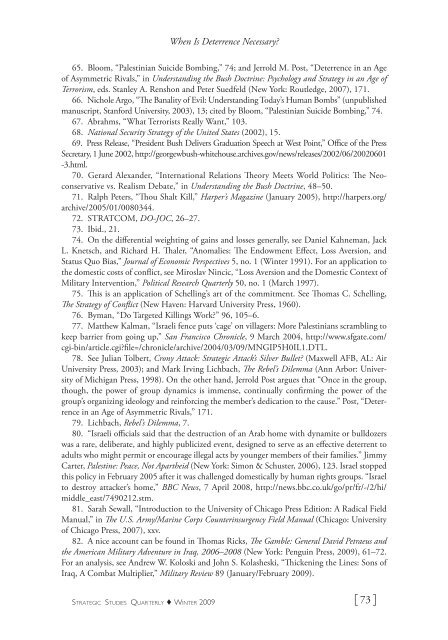When Is Deterrence Necessary? Gauging Adversary Intent
When Is Deterrence Necessary? Gauging Adversary Intent
When Is Deterrence Necessary? Gauging Adversary Intent
Create successful ePaper yourself
Turn your PDF publications into a flip-book with our unique Google optimized e-Paper software.
<strong>When</strong> <strong>Is</strong> <strong>Deterrence</strong> <strong>Necessary</strong>?<br />
65. Bloom, “Palestinian Suicide Bombing,” 74; and Jerrold M. Post, “<strong>Deterrence</strong> in an Age<br />
of Asymmetric Rivals,” in Understanding the Bush Doctrine: Psychology and Strategy in an Age of<br />
Terrorism, eds. Stanley A. Renshon and Peter Suedfeld (New York: Routledge, 2007), 171.<br />
66. Nichole Argo, “The Banality of Evil: Understanding Today’s Human Bombs” (unpublished<br />
manuscript, Stanford University, 2003), 13; cited by Bloom, “Palestinian Suicide Bombing,” 74.<br />
67. Abrahms, “What Terrorists Really Want,” 103.<br />
68. National Security Strategy of the United States (2002), 15.<br />
69. Press Release, “President Bush Delivers Graduation Speech at West Point,” Offce of the Press<br />
Secretary, 1 June 2002, http://georgewbush-whitehouse.archives.gov/news/releases/2002/06/20020601<br />
-3.html.<br />
70. Gerard Alexander, “International Relations Theory Meets World Politics: The Neoconservative<br />
vs. Realism Debate,” in Understanding the Bush Doctrine, 48–50.<br />
71. Ralph Peters, “Thou Shalt Kill,” Harper’s Magazine (January 2005), http://harpers.org/<br />
archive/2005/01/0080344.<br />
72. STRATCOM, DO-JOC, 26–27.<br />
73. Ibid., 21.<br />
74. On the differential weighting of gains and losses generally, see Daniel Kahneman, Jack<br />
L. Knetsch, and Richard H. Thaler, “Anomalies: The Endowment Effect, Loss Aversion, and<br />
Status Quo Bias,” Journal of Economic Perspectives 5, no. 1 (Winter 1991). For an application to<br />
the domestic costs of conflict, see Miroslav Nincic, “Loss Aversion and the Domestic Context of<br />
Military Intervention,” Political Research Quarterly 50, no. 1 (March 1997).<br />
75. This is an application of Schelling’s art of the commitment. See Thomas C. Schelling,<br />
The Strategy of Conflict (New Haven: Harvard University Press, 1960).<br />
76. Byman, “Do Targeted Killings Work?” 96, 105–6.<br />
77. Matthew Kalman, “<strong>Is</strong>raeli fence puts ‘cage’ on villagers: More Palestinians scrambling to<br />
keep barrier from going up,” San Francisco Chronicle, 9 March 2004, http://www.sfgate.com/<br />
cgi-bin/article.cgi?file=/chronicle/archive/2004/03/09/MNGIP5H0IL1.DTL.<br />
78. See Julian Tolbert, Crony Attack: Strategic Attack’s Silver Bullet? (Maxwell AFB, AL: Air<br />
University Press, 2003); and Mark Irving Lichbach, The Rebel’s Dilemma (Ann Arbor: University<br />
of Michigan Press, 1998). On the other hand, Jerrold Post argues that “Once in the group,<br />
though, the power of group dynamics is immense, continually confirming the power of the<br />
group’s organizing ideology and reinforcing the member’s dedication to the cause.” Post, “<strong>Deterrence</strong><br />
in an Age of Asymmetric Rivals,” 171.<br />
79. Lichbach, Rebel’s Dilemma, 7.<br />
80. “<strong>Is</strong>raeli offcials said that the destruction of an Arab home with dynamite or bulldozers<br />
was a rare, deliberate, and highly publicized event, designed to serve as an effective deterrent to<br />
adults who might permit or encourage illegal acts by younger members of their families.” Jimmy<br />
Carter, Palestine: Peace, Not Apartheid (New York: Simon & Schuster, 2006), 123. <strong>Is</strong>rael stopped<br />
this policy in February 2005 after it was challenged domestically by human rights groups. “<strong>Is</strong>rael<br />
to destroy attacker’s home,” BBC News, 7 April 2008, http://news.bbc.co.uk/go/pr/fr/-/2/hi/<br />
middle_east/7490212.stm.<br />
81. Sarah Sewall, “Introduction to the University of Chicago Press Edition: A Radical Field<br />
Manual,” in The U.S. Army/Marine Corps Counterinsurgency Field Manual (Chicago: University<br />
of Chicago Press, 2007), xxv.<br />
82. A nice account can be found in Thomas Ricks, The Gamble: General David Petraeus and<br />
the American Military Adventure in Iraq, 2006–2008 (New York: Penguin Press, 2009), 61–72.<br />
For an analysis, see Andrew W. Koloski and John S. Kolasheski, “Thickening the Lines: Sons of<br />
Iraq, A Combat Multiplier,” Military Review 89 (January/February 2009).<br />
Strategic Studies Quarterly ♦ Winter 2009 [ 73 ]
















